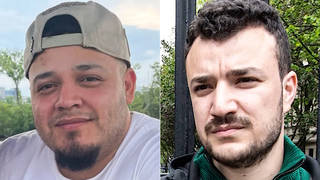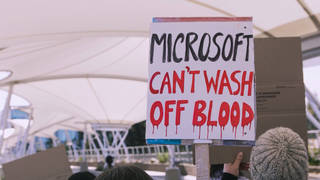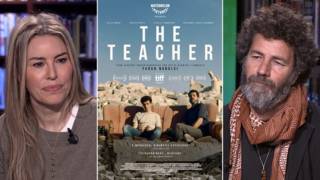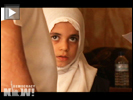
Guests
- Josh Stieberformer member of Bravo Company 2-16, the company involved in the 2007 US helicopter shooting in Baghdad. He left the military as a conscientious objector last year and is a member of Iraq Veterans Against the War
We speak with a former member of Bravo Company 2-16, the military unit involved in the 2007 helicopter shooting of Iraqi civilians that killed twelve people, including two Reuters employees, as seen on the military video released by WikiLeaks. “The natural thing to do would be to instantly judge or criticize the soldiers in this video,” says Josh Stieber. “Not to justify what they did, but militarily speaking, they did exactly what they were trained to do…If we’re shocked by this video, we need to be asking questions of the larger system, because this is how these soldiers were trained to act.” [includes rush transcript]
Transcript
JUAN GONZALEZ: We begin today with an update on the video released last week by WikiLeaks that depicts US troops killing twelve people, including two Reuters employees, and injuring at least two children in a suburb of Baghdad nearly three years ago. Defense Secretary Robert Gates told ABC’s This Week that the video, quote, “doesn’t show the broader picture of the firing that was going on at American troops.” He acknowledged that the video was “unfortunate” and “painful” but added that the incident had already been thoroughly investigated and the video, quote, “should not have any lasting consequences.”
Here’s an excerpt from that US military video released by WikiLeaks. This is the moment that US forces first open fire from a helicopter.
US SOLDIER 5: …there, one o’clock. Haven’t seen anything since then.
US SOLDIER 2: Just [expletive]. Once you get on, just open up.
US SOLDIER 1: I am.
US SOLDIER 4: I see your element, got about four Humvees, out along this —
US SOLDIER 2: You’re clear.
US SOLDIER 1: Alright, firing.
US SOLDIER 4: Let me know when you’ve got them.
US SOLDIER 2: Let’s shoot. Light ’em all up.
US SOLDIER 1: Come on, fire!
US SOLDIER 2: Keep shootin’. Keep shootin’. Keep shootin’. Keep shootin’.
US SOLDIER 6: Hotel, Bushmaster two-six, Bushmaster two-six, we need to move, time now!
US SOLDIER 2: Alright, we just engaged all eight individuals.
JUAN GONZALEZ: The video shows US forces watching as a van pulls up to evacuate the wounded. They again open fire from the helicopter, killing several more people and wounding two children inside the van.
US SOLDIER 1: Where’s that van at?
US SOLDIER 2: Right down there by the bodies.
US SOLDIER 1: OK, yeah.
US SOLDIER 2: Bushmaster, Crazy Horse. We have individuals going to the scene, looks like possibly picking up bodies and weapons.
US SOLDIER 1: Let me engage. Can I shoot?
US SOLDIER 2: Roger. Break. Crazy Horse one-eight, request permission to engage.
US SOLDIER 3: Picking up the wounded?
US SOLDIER 1: Yeah, we’re trying to get permission to engage. Come on, let us shoot!
US SOLDIER 2: Bushmaster, Crazy Horse one-eight.
US SOLDIER 1: They’re taking him.
US SOLDIER 2: Bushmaster, Crazy Horse one-eight.
US SOLDIER 4: This is Bushmaster seven, go ahead.
US SOLDIER 2: Roger. We have a black SUV —- or Bongo truck picking up the bodies. Request permission to engage.
US SOLDIER 4: Bushmaster seven, roger. This is Bushmaster seven, roger. Engage.
US SOLDIER 2: One-eight, engage. Clear.
US SOLDIER 1: Come on!
US SOLDIER 2: Clear. Clear.
US SOLDIER 1: We’re engaging.
US SOLDIER 2: Coming around. Clear.
US SOLDIER 1: Roger. Trying to -—
US SOLDIER 2: Clear.
US SOLDIER 1: I hear ’em — I lost ’em in the dust.
US SOLDIER 3: I got ’em.
US SOLDIER 2: Should have a van in the middle of the road with about twelve to fifteen bodies.
US SOLDIER 1: Oh yeah, look at that. Right through the windshield! Ha ha!
JUAN GONZALEZ: Saleh Mutashar is the man who was driving that van. He was taking his two children, age nine and six at the time, to school.
Well, earlier this month, journalists from the Icelandic National Broadcasting Service, who were part of the investigative team that released the US military video on WikiLeaks, visited the family of Saleh Mutashar, the driver of the van and the father of the two children. They showed his family the recently released video footage of the attack on the van that led to his death, and then spoke to his son Sajad, his nephew Anwar, and his widow Ahlam Abdelhussain.
AHLAM ABDELHUSSAIN: [translated] My husband did nothing wrong. He saved a wounded person and had his children with him in the car. How do I feel? What can I say? Why was he shot with his children in the car? They did nothing wrong. He was helping a journalist. What was his crime? What was the crime of our children who are left with no father and no support?
ANWAR: [translated] He was carrying wounded people during the American attacks. He was trying to help. They believe that someone who was carrying a gun will take his children along with him? Unbelievable. What can we do? God take revenge from the Americans. They destroyed us and destroyed our nations. What is the future of those children? They are orphans.
SAJAD MUTASHAR: [translated] I want to get our rights from the Americans who harmed us.
AMY GOODMAN: That was twelve-year-old Sajad Mutashar, injured in the July 2007 Apache helicopter attack on the Iraqi civilians, reacting to the video of the attack released by WikiLeaks. The boy’s mother says she has yet to receive compensation from the US military for the death of her husband or the injuries to her two children. She described the hardship she’s had to suffer since her husband was killed in July 2007.
AHLAM ABDELHUSSAIN: [translated] We used to live in a rented house. He worked as a construction worker. We didn’t have any other income. After his death, I was left with nothing. My children were wounded. We were devastated. My father-in-law took us to live with him. Life became very difficult. My children are still suffering from their wounds. My daughter still suffers from pain in her head and her stomach. My son is still in pain after his surgery. We don’t have a pension or any other income to rely on, so my father-in-law took us to live with him.
AMY GOODMAN: The attack also killed two Reuters employees: the photographer Namir Noor-Eldeen and his driver, a father of four, Saeed Chmagh.
Well, we’re joined right now from Washington, DC, by a former member of the company involved in this shooting attack, Bravo Company 2-16. Josh Stieber was not present at the time of this attack but was a member of the company at the time and served for fourteen months alongside the soldiers seen and heard in the video released by WikiLeaks. Josh left the military as a conscientious objector last year and is a member of Iraq Veterans Against the War.
Josh, welcome to Democracy Now! On this day, July 12th, 2007, where were you?
JOSH STIEBER: I was back on the main base and was not part of this mission, because I had chosen not to follow an order a couple days before, so some of my leaders were upset at me and didn’t trust me in a combat situation at that point.
AMY GOODMAN: Would you have been on the ground — that was the force that moved in on the van — or in the Apache helicopter?
JOSH STIEBER: I was in the company with the soldiers on the ground.
JUAN GONZALEZ: And Josh, when the unit got back to the base, what did you all hear about this incident?
JOSH STIEBER: Just kind of the basic details, that, you know, this is — this is what happened, that whoever perceived it as a threat and that different insurgents were killed, so just kind of the basic details, and people weren’t talking about it a whole lot.
AMY GOODMAN: When did you hear that among the twelve people who were killed were two Reuters employees, this young photographer Namir Noor-Eldeen and his driver Saeed Chmagh?
JOSH STIEBER: As far as I can remember, I didn’t learn about that until I read the book that was written about my unit, The Good Soldiers by Washington Post reporter David Finkel.
AMY GOODMAN: We’re going to take a break, then we’re going to come back to this discussion. Josh Stieber, a veteran of the company involved in the July 2007 attack on the Iraqi civilians. It was — a video of this was just released by the media watchdog group WikiLeaks.org. It’s believed someone in the military released this video to get the images out.
This is Democracy Now!, democracynow.org, the War and Peace Report. We’ll also find out why Josh left the military as a conscientious objector. Stay with us.
[break]
AMY GOODMAN: We’re joined by Josh Stieber in Washington, DC, a veteran of the company involved in the July 2007 shooting of twelve Iraqi civilians in the video released by WikiLeaks. He left the military as a conscientious objector last year and is a member of Iraqi Veterans Against the War.
Your reaction when you saw this videotape, Josh?
JOSH STIEBER: When I first saw it, I was, you know, kind of shocked that I recognized exactly what it was. And then, as I watched it a second time and then started to read about some of the reactions from it, I guess I was also surprised a little bit by kind of the nature of the conversations, because, you know, again, not to morally justify what happened — and, you know, as a conscientious objector, obviously I disagreed with our tactics — but I think the statements that have been put out by the military and by Secretary Gates yesterday have reaffirmed that what happened was by no means unusual.
So I guess the nature of the conversation, I think, is the really important thing to focus on here, in that, you know, the easy thing and maybe the natural thing to do would be to instantly judge or criticize the soldiers in this video, and again, not to justify what they did, but militarily speaking, they did exactly what they were trained to do. So I guess the point that I’m trying to make is that if we are shocked by this video — which, again, it is a very shocking video — if we’re shocked by this video, then we need to be asking questions of the larger system, because, again, this is how these soldiers were trained to act.
JUAN GONZALEZ: Well, Josh, I’d like to play some clips from the WikiLeaks video. Here the cockpit learns from the soldiers on the ground that the victims include children. One voice says, “Well, it’s their fault for bringing their kids [into a] battle.”
US SOLDIER 3: I’ve got eleven Iraqi KIAs . One small child wounded. Over.
US SOLDIER 1: Roger. Ah, damn. Oh, well.
US SOLDIER 3: Roger, we need — we need a — to evac this child. She’s got a wound to the belly. I can’t do anything here. She needs to get evaced. Over.
US SOLDIER 1: Well, it’s their fault for bringing their kids into a battle.
US SOLDIER 2: That’s right.
JUAN GONZALEZ: The whole question of how soldiers reacted to civilian casualties, could you talk about that? Your experience in the military when, on one of these operations, civilians were killed or wounded?
JOSH STIEBER: Yeah, I mean, I would say that it’s definitely very troubling, but I guess, thinking from the military mindset — and again, this is not trying to morally justify it, but to explain something from that perspective — that you have a lot of young, impressionable people that, I think, at one point were idealistic in why they enlisted and why they participated in the military, and they find themselves in this horrible situation where, again, it is acting out the training that we’ve been so instilled with to do things like this. And part of that training is the dehumanization of the people in whatever country we happen to be in. That’s, you know, been the process throughout the history of militaries, in general. So it’s a result of the training.
And I guess what I hear when I listen to that conversation in the helicopter is two things. One of them is that, as callous as it sounds, it seems to be beginning to have a little bit of remorse like, “Wow, we just — you know, this is what we actually just did,” and then a quick response or a quick excuse to not let it trouble you. And, you know, throughout my military training, there were different times where things would trouble me, as far back as basic training. And that’s kind of, I think, a natural human reaction, that, wow, this is what I’m being asked to do, but I’m told that doing these things is in the best interest of my own country. And I think, you know, this video should provide grounds for a much-needed conversation of whether or not that’s true. But again, speaking from the military perspective, that’s what people have going through their minds, so that callousness that the helicopter pilots have, one, is a result of military training that’s hammered into them, and two, what I hear is an excuse, like I feel like this isn’t right, but then that quick excuse that, oh, well, they shouldn’t have been there in the first place, to try and distance themselves from the act that just happened.
AMY GOODMAN: Do you recognize the voices?
JOSH STIEBER: Not in the helicopter, but from the troops on the ground, yes.
AMY GOODMAN: Let’s go to two more clips. In this part of the video, we see around eight Iraqis lying on the ground dead or badly wounded. The soldiers claim the victims have weapons and laugh about the shooting.
US SOLDIER 1: We’re still firing.
US SOLDIER 2: Roger.
US SOLDIER 1: I got 'em.
US SOLDIER 3: Two-six, this is two-six, we're mobile.
US SOLDIER 2: Oops, I’m sorry. What was going on?
US SOLDIER 1: God damn it, Kyle.
US SOLDIER 2: Sorry, hahaha, I hit ’em — Roger. Currently engaging approximately eight individuals, KIA, RPGs and AK-47s. Hotel two-six, Crazy Horse one-eight.
US SOLDIER 1: Oh, yeah, look at those dead bastards.
US SOLDIER 2: Nice. Good shootin’.
US SOLDIER 1: Thank you.
AMY GOODMAN: In this part, we hear voices from the cockpit laughing as a Bradley tank drives over the dead body of one of the Iraqi victims.
US SOLDIER 1: I think they just drove over a body.
US SOLDIER 2: Did he?
US SOLDIER 1: Yeah!
AMY GOODMAN: Josh Stieber, do you recognize those voices?
JOSH STIEBER: Those voices? No.
AMY GOODMAN: The voices you do recognize are which?
JOSH STIEBER: The ones granting permission to the folks in the helicopter when they ask for permission to open fire.
AMY GOODMAN: And who is giving the permission?
JOSH STIEBER: Those were different leaders and radio operators in the company.
AMY GOODMAN: Where are they?
JOSH STIEBER: I guess that is an important thing that I think needs to be considered with that video, is that, again, by no means morally justifying what happened, but I think just the seventeen-minute WikiLeaks clip is taking things a little bit out of context in what was going on that day, was that the troops on the ground were searching house to house, and the helicopters were assigned to keep watch over them, and so part of that is to eliminate any threat that comes up. That was, you know, what we were trained with regularly in the military.
And again, I would take so much of this just back to the training that we had. And one thing that I think about is one exercise. Some of my leaders would ask the younger soldiers what they would do if somebody were to pull a weapon in a marketplace full of unarmed civilians. And not only did your response have to be that you would return fire, even if you knew it was going to hurt innocent civilians, because you’re trying aim at the person with the weapon, the answer had to be yes, but it had to be an instantaneous yes. So, again, these things are just hammered into you through military training. So that’s, you know, the background of what the people in the helicopter had in their minds, so that they saw this as a threat.
And actually, looking at the video myself, you know, based on my training, what I saw in the video of what the people on the ground were holding in their hands, whether or not it was a camera, but again, from my military training, I would have, you know, been told that that was a military — militarily justifiable thing. And, you know, top sources have confirmed this. But again, if you watch the forty-minute video, they actually recovered an RPG shell, so I think there’s evidence that there were weapons involved. And I think, you know, the conversation has to be that the people in the helicopter and the people in the military were responding exactly as they had been trained.
From there, we can have a much-needed conversation about what does this training really look like, and I think there have been people out there trying to warn people, myself included, to trying to talk to people about just the things that the military trains people with, very psychological things, on a day-to-day basis. And then also the conversation that if these things are militarily justified, we have to ask if they’re morally justified. If we want things that the Secretary of Defense —-
JUAN GONZALEZ: Josh -—
JOSH STIEBER: — is saying this is acceptable —-
JUAN GONZALEZ: Josh -—
JOSH STIEBER: Yeah.
JUAN GONZALEZ: — on this issue of whether they’re morally defensible, could you talk to us about your decision to become a conscientious objector and how that was received and why you made that decision?
JOSH STIEBER: I mean, I got to the point where, you know, I was saying things like this and realized that this is what the military wants me to do, and this is not something that I can do or that I want to do as a person, based on my religious beliefs and based on who I want to be, that this is what the military is telling me is acceptable — and again, I think this video illustrates that — and me that this is wrong. And it got down to some very simple concepts of doing unto others, and I knew I wouldn’t want other people doing similar things like this to me, and not only what’s in the video, but just day-to-day things of where we would go in people’s houses and rip through their houses. I’m pretty sure most people in my country would be pretty upset by that. So I decided to leave the military as a conscientious objector.
And actually, that process, a number of soldiers were supportive of me, and they would tell me things like, “You know, we disagree with the war, too, but we don’t think it’s worth the effort to try and do anything about it.” So I think that’s a really important point to focus on with this conversation about the video, is that there are many soldiers who are struggling with what’s going on there. You know, I talk to a lot of them, and just about everybody I was with lost their idealism for why we were there. So they’re struggling through these ideas.
But then, me speaking out about this, I’ve been getting criticism as a conscientious objector, being called a baby killer and white trash for enlisting in the military, to begin with. So, in terms of people who don’t want this kind of thing to happen again, if the goal is to get these soldiers who are committing these acts to stop doing that, if they see me, who has stepped out, getting criticized by people who are saying war is not the right answer, then that’s not going to make them any more likely to want to make that step, either. So I think the important part of this conversation is how can we work together with those soldiers who are struggling through these things and try to work towards other alternatives and try and provide them an outlet to say, “This is wrong, and I’m not going to do it anymore.”
AMY GOODMAN: Josh Stieber, who gave the orders to shoot?
JOSH STIEBER: From what I see in the video, it wasn’t as much a permission — the folks in the helicopter asked the leaders on the ground if they could shoot, but it wasn’t more like, you know, you’re allowed to; it was more, you know, do you have any guys in the area that we might hit if we open fire? So I think it was the people in the helicopter, you know, saying, “We want to shoot. We want to make sure we’re not going to hit you,” and the people on the ground said, “Yeah,” you know, “you’re clear to fire.”
AMY GOODMAN: So who are those voices that you recognize that say, “Yes, you’re clear to fire”?
JOSH STIEBER: Different leaders of various rank in my company.
AMY GOODMAN: Do you know any of their names?
JOSH STIEBER: Yes. But — I mean, I think one of the things with this is that, again, the temptation can be to pinpoint this all on a few individual soldiers, and if we make a huge deal about the individual soldiers and don’t look at the larger military system, where, again, we’re hearing these things from the very beginning of basic training, then you might take your judgment out on a few individual soldiers —-
AMY GOODMAN: Well, Josh, let me ask you -—
JOSH STIEBER: — but it won’t change the process at all.
AMY GOODMAN: — let me ask you this question. The soldier that was asking for permission to take these kids to the US military hospital, who was denied permission, told to take them to an Iraqi hospital, which would probably not be as equipped, do you know that soldier?
JOSH STIEBER: Um, that one I’m not sure of. I’m not sure.
AMY GOODMAN: The effect on these soldiers who saw the children?
JOSH STIEBER: The effect, I know, it definitely has taken a toll. And I know the soldier who carried that child, and, you know, he was very uncomfortable with it. And when he got back, you know, like so many soldiers, was very troubled by it and didn’t — I think a number of soldiers don’t see any outlet or don’t see any option to want to talk about these things. And again, if me, who is taking this step and talking about it, is getting met with such harsh resistance, that’s not going to encourage other soldiers to take a step.
So this particular soldier, I know, has tried to solve his problems through alcohol. And unfortunately, that’s what a lot of soldiers turn to when they get back, is alcohol or possessions or just something to try and push these to the back of their mind, rather than to try to address the system that put us in this situation and encouraged us to do these things.
AMY GOODMAN: Are these soldiers now — after the video was released by WikiLeaks, are these soldiers starting to talk and get together now to talk about what to do, as others are calling for a reinvestigation of this?
JOSH STIEBER: The attitude that I’ve gotten from the soldiers involved, you know, who are my friends who I was there with, is generally — not completely across the board, but is generally — one of defensiveness, that they’re hearing all this criticism, and very strongly worded criticism — and again, I’m not saying — I’m not morally justifying what happened in the video. What my point is is that what these soldiers were doing was exactly as they had been trained to do. So here’s all these people criticizing them, but they’re saying that “I’m doing what I was supposed to do for my country.”
And I guess as I’ve been thinking about it, not only is it in the military, but it’s even in our general culture. I mean, thinking back to high school, I was taught things like, you know, the atomic bomb wasn’t morally wrong. It might have been strategically questionable, but this idea, even in history class, that, you know, at times it might be necessary to take civilian lives in order to accomplish your overall goals. So I think, as a society, we need to look at these things that put people — or put this mindset or put these ideas in people. And, you know, I think, again, this video is shocking, and we need to ask, how can we take that shock from the video and turn it into something positive? So whether that looks like people shocked by this video talking to their school boards and demanding for peace education classes or something to fix this larger system, rather than just point it on a few individuals.
AMY GOODMAN: Josh Stieber, we want to thank you for being with us, veteran of the company involved in the July 2007 shooting of the Iraqi civilians, the video released by WikiLeaks. You can go to our website, democracynow.org, to see various parts of it. Josh left the military as a conscientious objector last year and is a member of Iraq Veterans Against the War.












Media Options